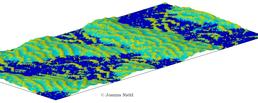Surface moisture-induced feedback in aeolian environments
- Investigators
- Joanna Nield

Simulated aeolian sand strips with superimposed ripples. Dark blue indicates wet surface, light blue wet sediment, yellow dry sediment, with intermediate colours indicating moderate surface moisture. See Nield (2011), Geology for further details.
Sand dunes develop as sand that is transported by wind, interacts with the surface over which it is moving. In coastal and semi-arid areas (e.g. Great Sand Dunes National Park, US), the amount of water on the surface influences how well the wind can move sand. Over short time scales, this moisture helps the wind to form accumulations of wet and dry sand bands on beaches. As these bands migrate, further accumulation occurs and we get the beginning of a larger dune. On a much longer time scale, in areas where there are well defined wet and dry seasons (e.g. Brazilian north coast), water may form pools between large dunes in the wet season, leaving behind a dune imprint in the dry season. These dune imprints can tell us something about climate and dune migration rates, helping us to unlock the secrets of past climate change. This research is summarised in [Nield (2011)] (http://geology.geoscienceworld.org/cgi/content/full/39/10/915?ijkey=1c/TIS9W5l4HU&keytype=ref&siteid=gsgeology), Geology ([doi:10.1130/G32151.1] (http://eprints.soton.ac.uk/183561/)). In this paper, both the short and long term influence of surface water in dune environments are included in a computer simulation model for the first time, the outputs of which highlight the significance of the duration of sand transport and surface interaction, and the importance of considering surface moisture influence in sandy environments.
Categories
Physical Systems and Engineering simulation: Earth surface dynamics, Sediment transport
Algorithms and computational methods: Cellular automata
Programming languages and libraries: C
Computational platforms: Iridis